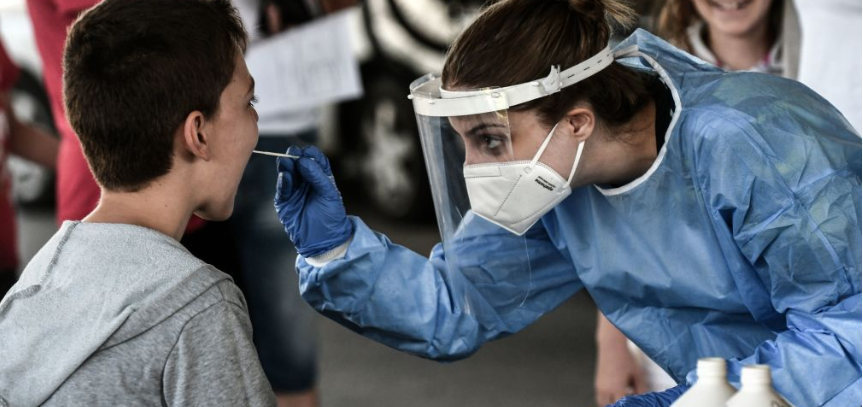Latest on COVID-19
- Home
- Latest on COVID-19
Why your negative antibody test might be wrong

There was a mini-epidemic around our way, back in February. When it was clear that the coronavirus was coming to Britain, everyone seemed to have it. Friends, family, parents at the school gate. I started to wonder if I’d had it, after I coughed a few times after going for a run in the cold air. One person I know even convinced themselves that they’d had it in, I think, November, which means there’s about a one-in-10 chance they’d have caught it directly from the bat.
Obviously, most of them will have been misdiagnoses, if you can call them “diagnoses” at all. Everyone was paranoid, and developing a bit of short-term hypochondria; and people don’t always have a good sense of the actual risk. (I remember, early on, seeing someone move seats on the Tube when someone else sneezed; back then, it was still hundreds of times more likely that the sneezer just had a cold.)
But a few seemed very real. People with dry coughs and fever and anosmia, being knocked out for quite some time — the real core symptoms. Testing wasn’t really up and running then (or for several months afterward), so unless they were hospitalised they weren’t tested, but it seemed pretty clear.
And then it got weird, because antibody testing became available, and several of these people with the core symptoms — honestly, I know of at least three, either directly or at one remove — tested negative. One of them had the “long Covid” symptoms, the post-viral fatigue and weakness that seems to last for months and is so reminiscent of ME/CFS. But their serology test was negative.
That person, incidentally, went onto a Facebook forum for long-lasting Covid sufferers to mention that — and had hundreds of replies from people saying similar things. There seem to be a lot of people who think they’ve had Covid, and who have had negative antibody tests. A decent percentage of them have had the proper core symptoms, or even the long Covid aftermath, and their tests, too, have come back negative.
Obviously some large number of these people will have been wrong. But a couple of weeks ago, I wrote a thing about antibodies and long-term immunity, and the concerns that vaccines wouldn’t work because the number of antibodies in patients’ bloodstream declined quite quickly.
The piece was largely saying that vaccines probably would work, but one acquaintance who’d had long Covid symptoms but a negative serology test got in touch, saying that they found it reassuring. That was because it suggested that a lot of people might have had the disease, but tested negative for antibodies, and a lot of the Covid sufferers, especially, are nervous about antibody tests; after all if they come back negative, it might make them look as if they’re malingerers or hypochondriacs.
A new paper out in preprint from the King’s College London team behind the Covid Symptom-Study app adds a bit more colour to this picture. It looked at 431 people who were already being tracked through a pre-existing study. They were followed with the Symptom-Study app from way back in March.
It found, essentially, that lots of people who had the really core symptoms, and even some who were swab-tested at the time, later tested negative for antibodies. It also found that lots of people who did test positive for Covid, either by swab or antibody, didn’t have all of the core symptoms.
“Of people who had clear symptoms associated with coronavirus,” says Dr Claire Steves, a KCL geriatrician who worked on the study, “about 50% of them didn’t have antibodies.” Not all of those people were swab-tested at the time, she says, “because testing wasn’t widely available,” but other studies have found that lots of people who were swab-tested then tested negative for antibodies.
This is all part of an increasingly complicated picture of the disease, says Dr Tim Spector, a colleague of Steves’ and the lead academic behind the COVID Sympton Study app. In an earlier study, Steves and Spector found that you could divide up Covid cases into roughly six categories, some with roughly flu-like conditions, others with mainly gastrointestinal or even neurological symptoms.
He speculates that the immune system may respond differently to each kind, and that having a strong antibody response may not be all that good a thing. “Clearly all our immune systems are working in very different ways,” he says. “We think patients with long duration symptoms have some failure to clear the virus properly and it is stuck somewhere in the nervous system or in the gut.” Other immune responses, such as T-cells, may be going on. The team is working to see if patients do have detectable T-cell responses, but the tests for that are time-consuming and expensive and can’t be done via home testing — you need live T-cells from fresh blood — so it is not something that could be rolled out at scale.
Fundamentally, both Spector and Steves say, even if someone had a negative antibody test, you can’t rule out that they had the disease: “They’re in good company,” says Spector. “About 50% of people with classic symptoms didn’t have the antibodies.” The more severe the disease, the less likely a negative response is — partly, Steves and Spector point out, because very severe disease appears to be at least partially caused by the antibody response. But it absolutely makes sense that many people would have the disease and then appear negative in the serology tests.
There’s a bigger picture here, which is that if lots of people have the disease and then test negative, it changes our understanding of how widely the disease has spread in the population. Back in early July there were some shocking papers that came out, notably one from Spain which despite an awful outbreak found that only 5% of the population had a positive antibody response. It really set the scale of the problem into perspective, and how far from herd immunity we were.
These KCL findings — if they’re confirmed, I should say, because it’s still a relatively small study and because the sample might not be entirely representative — might shift that somewhat. Spector and Steves say that it could be that serology tests miss up to 50% of real cases. If that’s true, then up to about 10% of Spanish people may have had the disease — and perhaps more relevantly to most readers of this, up to 12% of British people, double the 6% estimate from the ONS. That’s an upper bound, and “it’s probably more likely in the middle”, says Steves. So it’s good news, but only cautiously so; it doesn’t give much support to wilder ideas that half of the population will have had it. Spector still puts the infection fatality rate at around 1%.
It should, however, be reassuring for the — probably quite large — group of people who were sure they had had the disease, and then tested negative when the antibody testing became available. There will also be a large cohort of people who genuinely had it, who suffered through quite severe symptoms or even long Covid, and were then told they never had it. That said, I’m sure that most of the north London hypochondriacs who convinced themselves they had the ‘rona back in February and March were wrong.
Read more: https://unherd.com/2020/08/why-your-negative-antibody-test-might-be-wrong/

